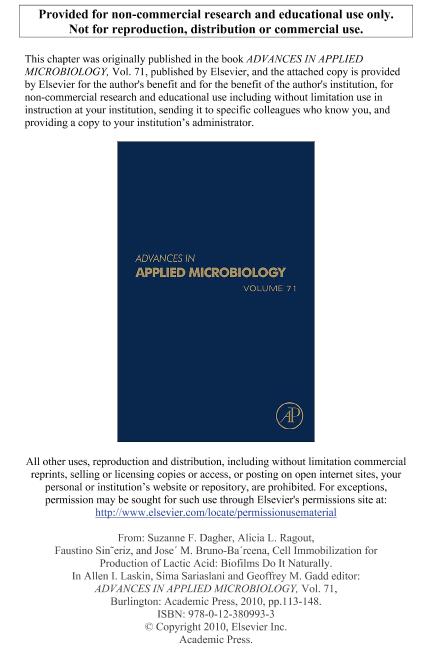Mostrar el registro sencillo del ítem
dc.contributor.author
Dagher, Suzanne F.
dc.contributor.author
Ragout, Alicia Leonor

dc.contributor.author
Siñeriz, Faustino

dc.contributor.author
Bruno Bárcena, José M.
dc.date.available
2019-04-04T21:24:28Z
dc.date.issued
2010-12
dc.identifier.citation
Dagher, Suzanne F.; Ragout, Alicia Leonor; Siñeriz, Faustino; Bruno Bárcena, José M.; Cell Immobilization for production of lactic acid: Biofilms do it naturally; Elsevier Academic Press Inc; Advances In Applied Microbiology; 71; 12-2010; 113-148
dc.identifier.issn
0065-2164
dc.identifier.uri
http://hdl.handle.net/11336/73238
dc.description.abstract
Interest in natural cell immobilization or biofilms for lactic acid fermentation has developed considerably over the last few decades. Many studies report the benefits associated with biofilms as industrial methods for food production and for wastewater treatment, since the formation represents a protective means of microbial growth offering survival advantages to cells in toxic environments. The formation of biofilms is a natural process in which microbial cells adsorb to a support without chemicals or polymers that entrap the cells and is dependent on the reactor environment, microorganism, and characteristics of the support. These unique characteristics enable biofilms to cause chronic infections, disease, food spoilage, and devastating effects as in microbial corrosion. Their distinct resistance to toxicity, high biomass potential, and improved stability over cells in suspension make biofilms a good tool for improving the industrial economics of biological lactic acid production. Lactic acid bacteria and specific filamentous fungi are the main sources of biological lactic acid. Over the past two decades, studies have focused on improving the lactic acid volumetric productivity through reactor design development, new support materials, and improvements in microbial production strains. To illustrate the operational designs applied to the natural immobilization of lactic acid producing microorganisms, this chapter presents the results of a search for optimum parameters and how they are affected by the physical, chemical, and biological variables of the process. We will place particular emphasis upon the relationship between lactic acid productivity attained by various types of reactors, supports, media formulations, and lactic acid producing microorganisms.
dc.format
application/pdf
dc.language.iso
eng
dc.publisher
Elsevier Academic Press Inc

dc.rights
info:eu-repo/semantics/openAccess
dc.rights.uri
https://creativecommons.org/licenses/by-nc-sa/2.5/ar/
dc.subject.classification
Biología Celular, Microbiología

dc.subject.classification
Ciencias Biológicas

dc.subject.classification
CIENCIAS NATURALES Y EXACTAS

dc.title
Cell Immobilization for production of lactic acid: Biofilms do it naturally
dc.type
info:eu-repo/semantics/article
dc.type
info:ar-repo/semantics/artículo
dc.type
info:eu-repo/semantics/publishedVersion
dc.date.updated
2019-03-26T20:32:32Z
dc.journal.volume
71
dc.journal.pagination
113-148
dc.journal.pais
Estados Unidos

dc.journal.ciudad
Burlington
dc.description.fil
Fil: Dagher, Suzanne F.. North Carolina State University; Estados Unidos
dc.description.fil
Fil: Ragout, Alicia Leonor. Consejo Nacional de Investigaciones Científicas y Técnicas. Centro Científico Tecnológico Conicet - Tucumán. Planta Piloto de Procesos Industriales Microbiológicos; Argentina
dc.description.fil
Fil: Siñeriz, Faustino. Consejo Nacional de Investigaciones Científicas y Técnicas. Centro Científico Tecnológico Conicet - Tucumán. Planta Piloto de Procesos Industriales Microbiológicos; Argentina
dc.description.fil
Fil: Bruno Bárcena, José M.. North Carolina State University; Estados Unidos
dc.journal.title
Advances In Applied Microbiology

dc.relation.alternativeid
info:eu-repo/semantics/altIdentifier/doi/https://dx.doi.org/10.1016/S0065-2164(10)71005-4
dc.relation.alternativeid
info:eu-repo/semantics/altIdentifier/url/https://www.sciencedirect.com/science/article/pii/S0065216410710054
Archivos asociados
